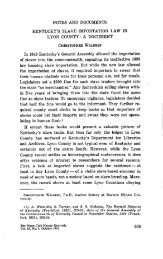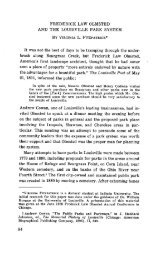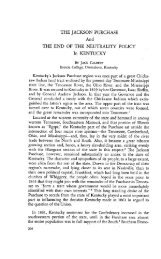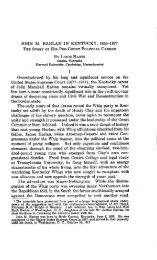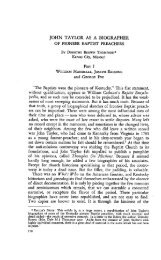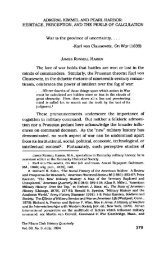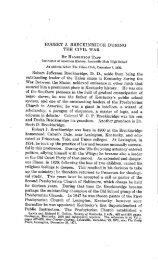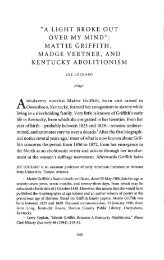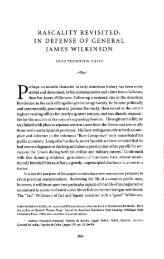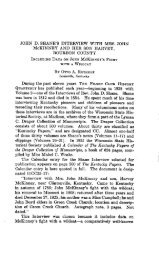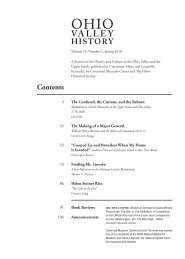Himlerville: Hungarian Cooperative Mining in Kentucky - The Filson ...
Himlerville: Hungarian Cooperative Mining in Kentucky - The Filson ...
Himlerville: Hungarian Cooperative Mining in Kentucky - The Filson ...
Create successful ePaper yourself
Turn your PDF publications into a flip-book with our unique Google optimized e-Paper software.
540 <strong>The</strong> <strong>Filson</strong> Club History Quarterly [October<br />
company were $4,500 owed to Mart<strong>in</strong> County and $4,000 owed to<br />
the federal government. <strong>The</strong> receivers had only $12,382 to meet<br />
these obligations. <strong>The</strong> bankruptcy court, after considei'<strong>in</strong>g the<br />
depressed state of the coal <strong>in</strong>dustry, decided that the Himler<br />
Coal Company should be sold to pay the tax liens and first<br />
mortgage. A date of sale was set for 10 August 1928 at 10:00<br />
A.M. 76<br />
Add<strong>in</strong>g to the cooperative's difficulties was the clos<strong>in</strong>g of<br />
the Mart<strong>in</strong>-Himler State Bank on 24 June 1928. Bank affairs<br />
were placed <strong>in</strong> the hands of H. H. Shanks, deputy state bank<strong>in</strong>g<br />
commissioner for <strong>Kentucky</strong>. Shanks was ordered to liquidate<br />
the bank's assets. Depressed coal prices were blamed for caus<strong>in</strong>g<br />
the bank's failure. At the time of its failure, the Mart<strong>in</strong>-Himler<br />
State Bank, which was also a cooperative <strong>in</strong>stitution, had capital<br />
stock of $25,000, a cash surplus of $6,000, and deposits of<br />
$80,000. Accord<strong>in</strong>g to the New York Times, no depositor lost a<br />
penny as a result of the bank's failure.<br />
<strong>The</strong> sale of the Himler Coal Company was delayed until 10<br />
January 1929 to provide opportunity for the <strong>Hungarian</strong>s to pay<br />
off the <strong>in</strong>debtuess. After all efforts failed, the company was<br />
purchased at public auction by Arch Hewit, a West Virg<strong>in</strong>ia<br />
coal operator who changed the company's name to the Mart<strong>in</strong><br />
County Coal Corporation. <strong>The</strong> $65,000 he paid was a fraction<br />
of the company's actual worth. Two days after the sale Hewit<br />
sent a work crew to repair the property <strong>in</strong> preparation for<br />
resum<strong>in</strong>g operations which had stopped <strong>in</strong> July 1928. American<br />
workers moved <strong>in</strong>to <strong>Himlerville</strong>; most of the <strong>Hungarian</strong>s moved<br />
away. <strong>Himlerville</strong>'s residents scattered throughout Appalachia<br />
and beyond. Some went to New Camp, West Virg<strong>in</strong>ia; South<br />
Williamson, <strong>Kentucky</strong>; Red Jacket, <strong>Kentucky</strong>; Cov<strong>in</strong>gton, Ken-<br />
76 Ibld.<br />
77 "<strong>Kentucky</strong> Bank Closes," New York Times, 25 tune 1928, p. 33 states that<br />
<strong>Himlerville</strong>'s bankruptcy was caused by "conditions <strong>in</strong> the m<strong>in</strong><strong>in</strong>g <strong>in</strong>dustry on<br />
which the town was dependent." For an excellent discussion of the effects of<br />
the boom/bust coal cycle on eastern <strong>Kentucky</strong>, see Harry M. Caudill, Night<br />
Comes to the Cumberland$, 141-215.



